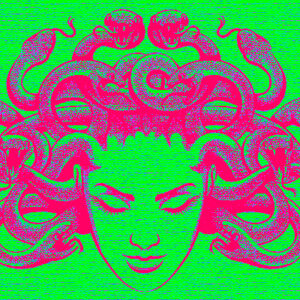Every woman who enjoys horror films has at some point felt the need to explain herself.
The interaction begins cordially, among mixed company at a gathering of family or friends. The chit chat shifts to movies, and she mentions a scary one she’s just watched—because that’s suitable for small talk, right?
Wrong. Whether it’s number one on Netflix or a gnarly grindhouse flick from the 70s, her interlocutor has no interest in discussing the topic further. “I can’t watch horror,” they’ll say, often with a grimace or performative little shudder. The follow-up question needn’t be verbalized; it hangs in the now airless room: “How can you?”
The passage of judgment is palpable, but it’s not a stranger’s opinion that disarms her. It’s that she’s asked herself the same question countless times and can’t find—much less articulate—an answer that feels truthful.
Politesse prevents no one from asking horror programmer, author, and filmmaker Kier-La Janisse this question explicitly, publicly. “I give them the stock answers: catharsis, empowerment, escapism and so on,” she wrote ten years ago, in the forward to her groundbreaking 2012 book, House of Psychotic Women. “Less easy to explain is the fact that I gravitate toward films that devastate and unravel me completely.”
From the outset, Janisse makes clear that she won’t spill a drop of ink defending her penchant for horror and exploitation fare. As she alludes, feminist film critics have done enough casework to provide pat explanations. Her book begins where peer-reviewed research ends. “I wanted to know why I was crazy,” she states as her mission.
The book—subtitled An Autobiographical Topography of Female Neurosis in Horror and Exploitation Films—is split into two parts: autobiography, and an index of films that constitute a “Psychotic Women” subgenre. In the first half, Janisse charts the course of her life through anxious peaks and depressive valleys. Revisiting traumatic moments—walking in on her mother’s rape as a toddler, being shuffled through the foster care system as a teen delinquent, getting divorced as a young woman—she surveys the damage but refrains from kicking up dirt. She shares autobiographical details matter-of-factly, training her psychoanalytic eye on neurotic heroines.
“We have more patience, or perhaps even empathy, for fictional characters than we do their real-life counterparts,” she explains at one point. “Faced with neurosis in film or literature, we want to investigate rather than avoid.”
Through the process of comparing her struggles with on-screen proxies, Janisse arrives at cathartic conclusions. In a chapter on fraught familial dynamics, she compares her mother—also a domestic abuse survivor, and an alcoholic—to the eponymous heroine of Let’s Scare Jessica to Death. Devoid of context, the connection is a head-scratcher. But Janisse’s book is entirely contextual—it’s an investigation, after all—and the associations themselves speak to how Janisse relies on her filmic knowledge to navigate the world. She acquaints us with Jessica in a synopsis inflected with commentary.
In the 1979 film, Jessica, fresh from a psych ward, moves to a Victorian house in a rural town to convalesce with her husband and a mutual male friend. But upon arriving, she finds an attractive young woman already occupying it (given that she’s soon thereafter revealed to be a vampire, this is bad news). Though she’s suspicious from the jump, Jessica welcomes the entity and stays smiling even as the vampiress moves to seduce all the men in her orbit.
Janisse sees her mother in Jessica’s shaky desperation to maintain composure. She concludes: “[Jessica’s] guilt over not being able to ‘act normal’ only exacerbated her awkwardness and invited the kind of self-hatred that would unravel her.” Empathy for Jessica, we can assume, brings Janisse closer to a place of forgiveness for her mother.
Moments like these read as breakthroughs, and appear to occur organically, in real time, through the act of writing. Janisse seems to gradually work through her romantic relationships in the latter portions of the autobiography, which cover her twenties and thirties. In a chapter on repression (courtesy of Catholicism), she writes of a destructive relationship with a younger man, relating it to the central “romance” of The Piano Teacher.
In Isabelle Huppert’s (once again, eponymous) character, Janisse sees reflected the masochism of her guilt and its co-conspirator: obsessive compulsion. In Huppert’s young lover, meanwhile—“A cocky scenester who goes after the most difficult woman he can find and then blames her when he’s not up to the challenge”—she recognizes her ex, and a pattern: “Clearly some combinations are worse than others, and for some reason, the worst combinations are always my favourite,” she confesses.
In the penultimate chapter, Janisse progresses even further on this front. She summons three heroines, each of whom represents her propensity for sabotage and a go-to response: Isabelle Adjani in Possession (fits of rage), Joan Fontaine in Rebecca (irrational jealousy), and Charlotte Gainsbourg in Antichrist (displacing blame). Of the three, Gainsbourg’s character—bereft in the aftermath of the accidental (?) death of her child—is the least sympathetic. But through implicitly drawing from her own experience, Janisse imbues Gainsbourg’s character with an interiority that director Lars Von Trier seems less interested in:
Throughout the course of the film, she moves responsibility around—from herself, to her husband, to Satan, to nature, and back to herself as a vehicle of nature—all the while desperately clutching for someone to blame. Assigning blame is a means of compartmentalizing… this is her attempt at creating order.
Janisse ends this chapter with a stunningly clear-eyed conclusion: “So as much as I habitually spend years mourning the end of a relationship, it’s slowly dawned on me that I don’t like being in them. And I take it out on my partner that they’ve trapped me into a life I don’t want.” The juxtaposition suggests that movie-watching helped Janisse come to this realization.
Reading House for the first time, this line slapped me in the face as hard as any scene or line or stray synapse from a movie ever has. If life imitates art and vice versa, so does writing that demonstrates how to read, interpret, and channel common sources of interest.
I spoke with Janisse recently, on the occasion of the book’s tenth anniversary. She elaborated on her ongoing inclination to seek out “psychotic women” in movies: “In my experience with these types of films, it’s like replaying old bad behaviors and revisiting them from a position of control,” she said. “But also I feel that in my case, the women in these movies help me be in control.” Her explanation homes in on the real-world application of life experience and know-how, which is less about literal survival and more about ordinary, continuous surviving. She leans on lessons learned from “psychotic women” in film to make her way through ordinary life. It’s only natural they should play a role in her life’s story.
When House of Psychotic Women was first published in 2012, it was highly unusual to write criticism that centered personal experience. This is hard to fathom in 2022, but as recently as 2016, Ian MacAllistair-McDonald wrote in LA Review of Books that he’d never read anything quite like it. The only basis of comparison he could find was the movie High Fidelity and in John Cusack’s methodology for sorting his record collection autobiographically.
Back in 2004, academic Julie Tharp wrote explicitly of the aversion of drawing from personal experience in film criticism, in a chapter from Autobiographical Writing Across Disciplines. The chapter—titled “When the Body is Your Own”—deals with the conundrum of remaining an impartial critic of horror as a woman. She recounts attending a conference wherein a male professor cautioned against “fan tendencies” (meaning emotional involvement) and decreed that film critics had a duty to “discipline themselves,” especially when viewing works that upset the senses. During a presentation of clips of women being stalked, murdered, and mutilated, Tharp burst into tears. “What interested me was myself,” she demurs.
Tharp goes on to assert that empathy shouldn’t be considered a weakness, and cites a British Film Institute survey that found that female viewers with firsthand experience of violence were more sensitive to its representation on-screen. They were “more subtle and complex in their readings, more concerned about the possible effects and more demanding in their expectations of the producers of such content.”
A “micro-perspective,” in its vulnerability, can reach across the barriers that “socially conscious criticism” has the potential to erect.“Identification, in other words, is not inimical to critical thinking,” Tharp writes.
It took years (and the rise of internet journalism and Twitter) for this sentiment to become mainstream—and then it happened so quickly that a boom and bust seemed to occur simultaneously.
A Vox article from 2017 titled “Hot Takes and Problematic Faves: The Rise of Socially Conscious Criticism” examined the downsides of the very phenomenon that Tharp had envisioned as progress: of critics being “more demanding in their expectations of the producers.” In this type of criticism, the “I” is oftentimes implicit. Author Jaime Weinman rightfully places the trend into context, pointing out that Pauline Kael, for instance, was never one to not let her personal tastes or politics bleed through the page. The problem, he argued, was in the formulaic nature of such writing. “The critic praises ‘good’ tropes that are present in the work, and asks whether ‘bad’ tropes are subverted or questioned. If the work conveys messages the critic agrees with, it earns a passing grade.” Personal perspective is sacrificed at the altar of a bodiless body: critics of critics.
That said, Weinman also found a “big upside,” once again hearkening back to Tharp’s assessment: “Socially conscious criticism compels critics, audiences, and creators to take art seriously.”
Janisse notes this shifting of tides in the foreword to House’s new edition. She includes a disclaimer:
Another thing readers new to this edition of the book will note is that it is informed by the perspective of a white, cishet woman from a specific economic background, and that is because I am not an academic studying these films from a remove—this book is transparently and defiantly autobiographical. It does not stand as the final word on anything except for how homicidal I was or wasn’t on a certain day when I wrote about a certain film.
Put another way (by Mac-Allister–Mcdonald): Janisse “adopts a micro-perspective, avoiding broad sociopolitical readings of the films in favor of deeply psychological ones.”
Another buzz phrase that’s taken flight in recent years, “lived experience,” refers to a type of criticism that foregrounds a unique (to varying degrees) perspective, often with sociopolitical implications. The pieces usually announce themselves with headlines that follow a clickable template—”I’m this [identity] and this is what I have to say about that [movie].” It’s easy to mock articles with headlines that come dangerously close to sounding like XOJane’s notorious “I Lived It” series. And at times, well-intentioned calls for writers tack on so many qualifiers as to become parodically exclusionary. (I’m reminded of a tweet I saw about a year ago, soliciting pitches from QTPOC journalists to write about how the very white, very heterosexual romance/drama Ghost World had impacted their lives. If the publication’s archives are to be trusted, the editor never found a taker.)
On the other hand, why wouldn’t I want to read a sex worker take on the film Pleasure? Or—praise god—a six-foot-tall woman’s thoughts on Attack of the 50 Foot Woman? Best-selling essayists like Leslie Jamison and Carmen Maria Machado have weighed in on Hereditary and Jennifer’s Body, respectively. The release of last year’s The Lost Daughter—a not–quite horror film that leverages genre tropes to expose the angst of motherhood—precipitated a flurry of pieces written by women with children who identified with Olivia Coleman’s “unnatural mother.” Works like these seem a reversal of the “hot takes” that Weinman describes, written in preemptive defense of films that pose morally questionable content. Whatever the case, critics petitioned for empathy: for Coleman’s character, for mothers, for themselves.
Horror criticism is especially receptive to personal perspectives. All of us who gravitate toward the genre but who don’t fit the stereotypical profile of its fandom have rehearsed a response to the unspoken question raised at the start of this piece. I can imagine the myriad, loaded iterations. In addition to representing women as meat to be minced, horror has historically cast Black men as first victims, LGBTQ+ characters as villains, foreigners of any stripe as witch doctors. We find representation in our fears being confirmed.
Critic Angelica Jade Bastién begins an article on horror in Atlanta’s second season with a caveat similar to, yet different from, Janisse’s at the start of House: “Horror may seem like an unlikely obsession for a young black girl growing up on the shores of Miami,” she writes. “But so much of blackness in America carries an undercurrent of dread, in which the prosaic points of everyday life—wearing a hoodie to run an errand, attending church, passing a huddle of cops while walking through your own neighborhood—are fraught with meaning and reminders of the potential for violence.” Later in the piece, she directly quotes Janisse and the book to describe the profound impact a particular episode had on her: “A good horror film will more often make me cry than make me shudder.”
A “micro-perspective,” in its vulnerability, can reach across the barriers that “socially conscious criticism” has the potential to erect. In our attempts to find ourselves in art, sometimes we hew too close to what we know. Movies—especially the odd and/or unsettling ones—are a point of convergence, and the resonance that writers like Bastién and MacAllistair-McDonald find in House is testament to how cards-on-the-table criticism can be instructive to viewing.
In House of Psychotic Women, I found a root cause of why I’m crazy a few paragraphs removed from a passage on Antichrist. Before reading Janisse’s book, I probably wouldn’t have mentioned something like that to others—much less put it in writing.

















